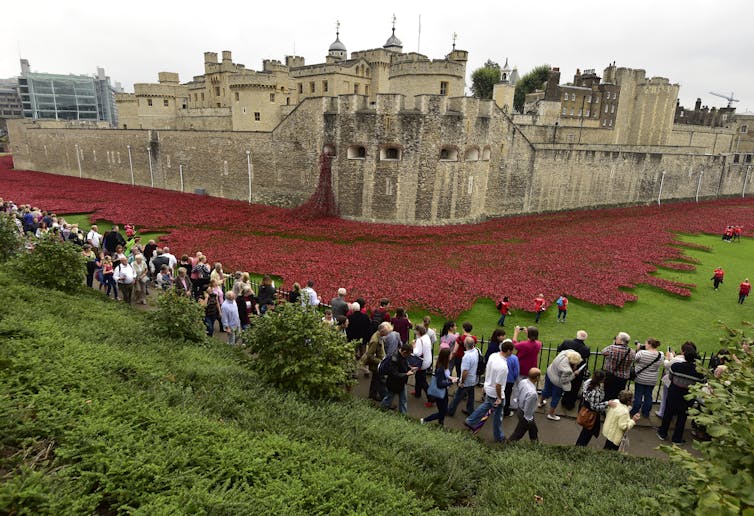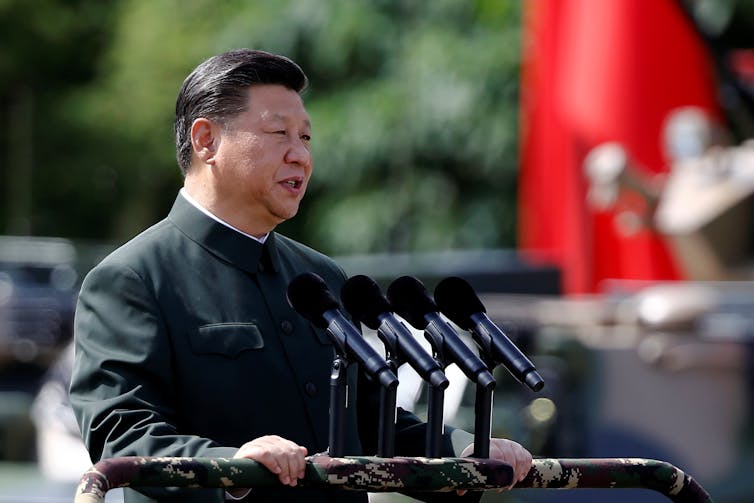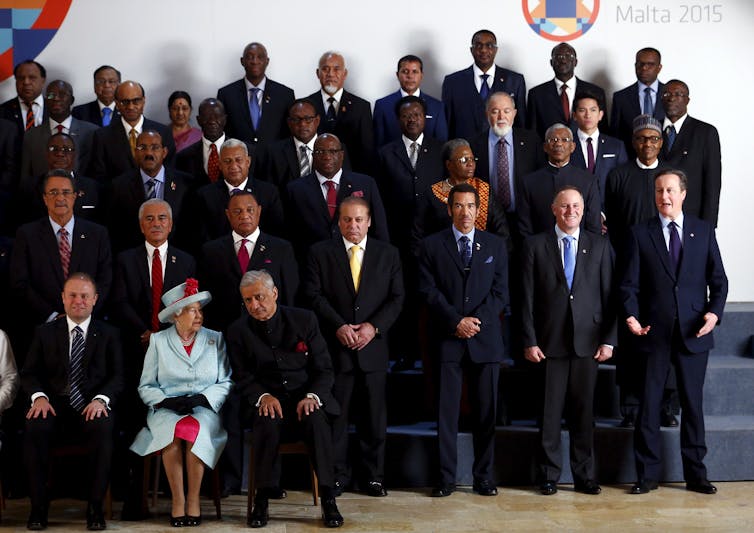The ties that (still) bind: the enduring tendrils of the British Empire
- Written by Julianne Schultz, Founding Editor of Griffith REVIEW; Professor, Griffith Centre for Social and Cultural Research, Griffith University
This piece is republished with permission from Commonwealth Now, the 59th edition of Griffith Review. Articles are a little longer than most published on The Conversation, presenting an in-depth analysis on the relevance of the Commonwealth of Nations in today’s geopolitical landscape.
Twelve years after William the Conqueror sailed across what’s now known as the English Channel to invade England, kill the king and claim the crown in 1066, he constructed the Tower of London.
Defiant locals viewed the stone tower, built into the remnants of the city’s Roman wall, as a symbol of the oppression of the continental regime. For the new monarch it was an important defensive hold on the north bank of the Thames, a useful place for temporary retreat if needed.
Over the following millennia the tower, more than any other building, has represented the power of the throne: a palace, treasury, public-record office, mint, menagerie and, most famously, a prison – the place where opponents were imprisoned and, sometimes, executed.
Now it has more than a touch of Disneyland – a World Heritage site visited by nearly 3 million people a year, and home to the crown jewels, the most glittering embodiment of a former empire.
Sentiment, glamour, heritage and power are a heady mix, and over the past decade the tower has gone from being a dour embodiment of imperial might to the place that one in ten of those who come to the second-most-visited city in the world pay to see.
It is one of six historic Royal Palaces, a royal charity with commercial and political clout. This was symbolised most compellingly in 2014 when the precinct was covered with nearly 1 million red ceramic poppies – one for each of the 888,246 British and Commonwealth soldiers killed in the first world war.
The unexpected and overwhelming success of Blood Swept Lands and Seas of Red, and subsequent sale of each flower, presented the challenge of success for the tower’s management. What next could match this achievement?
In 2017, I was a member of a group of international cultural leaders invited to meet with the tower’s executive to brainstorm new ideas that could help continue this success. We were a diverse group of artists and administrators from many countries.
Those from the former colonies – South Africa, Uganda, India, Malaysia, Singapore, Hong Kong, New Zealand and Australia – had plenty of suggestions:
include the history of the empire (those jewels…)
invite artists from the Commonwealth to create and present works that engage with history
provide new points of connection with the City of London, and with local communities in East London – many of whom trace their heritage to lands once ruled by Britannia.
The initial reaction was swift and somewhat unexpected. “What has that got to do with the tower?” one executive asked, his face revealing his genuine astonishment.
To those of us from the former colonies, who had grown up in places named for long-forgotten monarchs and were quickly discovering how much we had in common, it was straightforward. The empire had been built in the name of, and to the benefit of, the Crown. In country after country, on five continents, when independence was granted or won, the royals presided and then departed.
By the end of the day, it seemed there was a polite hint that this unexpected idea might possibly be something that might be considered – maybe. None of us left the meeting thinking it was likely the tower would include a more robust representation of the legacy of empire anytime soon, let alone attempt to reconcile what had been done in the name of the Crown.
As those who opposed William the Conqueror had learnt, like their successors in far-flung lands who were later subjected to British rule: to the victor goes the spoils.
 In 2014, the Tower of London precinct was covered with nearly 1 million red ceramic poppies.
Reuters/Toby Melville
In 2014, the Tower of London precinct was covered with nearly 1 million red ceramic poppies.
Reuters/Toby Melville
A changed power balance
We are so accustomed to hearing about American exceptionalism that British exceptionalism is rarely discussed. But, as the epigenetic precursor of the American condition, it deserves consideration. It may help make sense of the Brexit vote, which mystifies those not steeped in centuries of British myth-making and its resurgent Europe-as-other drumbeat over the past two decades.
It did not take long after the narrow vote to leave the European Union was declared in June 2015 before a new phrase intruded into public discussion.
Seventy years after the war that marked the end of the British Empire, a quaint, ahistorical notion emerged. In the jargon of the day, it was time for the Commonwealth to become Empire 2.0: a sphere of influence with one-third of the world’s population, one-fifth of global trade, and the dominant global language.
It did not take long before British political leaders were invoking this revival, reciting Rudyard Kipling on journeys abroad, conjuring a nostalgic vision of a wealthy mother country enriched by trade with the former colonies.
No-one bothered to ask whether this vision was shared by the independent states that had once been part of an empire. When they did, the answer was unexpected. The power balance had changed – trade with Europe, China and the US were more important.
If there is a moment that marks the end of the British Empire it was when the Royal Yacht Britannia sailed out of Hong Kong’s Victoria Harbour at midnight on June 30, 1997, on her last voyage. Charles, Prince of Wales, was there to oversee the handover to China, or what he called “the great Chinese takeaway”, with accompanying displays of military might and unlikely promises of “one country with two systems”.
On the flight back to London, Charles wrote in his diary that Prime Minister Tony Blair:
… understands only too well the identity problem that Britain has with the loss of an empire and an inability to know what to do next. Introspection, cynicism and criticism seem to have become the order of the day and clearly he recognises the need to find ways of overcoming apathy and loss of self-belief by finding a fresh national direction.
Charles was surprised to realise that he was seated in business class, and the Labour politicians were on the lower deck of the British Airways jumbo in first class:
Such is the end of empire, I sighed to myself.
Two decades later, as the Empire 2.0 dream gained some traction in Britain, Chinese President Xi Jinping celebrated the anniversary of the handover by stressing the overwhelming importance of China being “one country”.
At that moment it was unequivocally clear that power and influence had moved east. Beijing was now the emerging global epicentre.
 China under Xi Jinping is emerging as the global epicentre.
Reuters/Damir Sagolj
China under Xi Jinping is emerging as the global epicentre.
Reuters/Damir Sagolj
The decline of British exceptionalism
The creation in the 1960s of what was called the “New Commonwealth” was an example of British exceptionalism.
The New Commonwealth was conceived as a progressive league of nations with some shared history, values, institutions and language, which came into its own as negotiated settlements and bloody wars of independence in the former colonies concluded in the years after the second world war. Never before had a fallen empire found such an ingenious way to hold on to influence.
The New Commonwealth marked the beginning of a grand experiment. It extended rights and recognised the connection of people from beyond the eight nations that founded the Commonwealth in 1949, to those from former colonies in the rest of the world.
During the years of Empire, the “mother country” had a special appeal, and people gravitated to the “green and pleasant land” in the north Atlantic to study and work.
As the Commonwealth grew, more people came from equatorial lands to work and live in British cities. As novelist Zadie Smith reflected:
… to have been raised in London, with, say, Pakistani Muslims in the house next door, Indian Hindus downstairs, and Latvian Jews across the street, is thought of, by others, as evidence of a specific historical social experiment …
Of course, as a child I did not realise that the life I was living was considered in any way provisional or experimental by others: I thought it was just life. And when I wrote a novel about the London I grew up in, I further did not realise that by describing an environment in which people from different places lived relatively peaceably side by side, I was “championing” a situation that was in fact on trial and whose conditions could suddenly be revoked.
Britain changed as a result. But when it joined the Common Market in 1973, the hard work of interrogating and reconciling the past was pushed aside, before a settled understanding of the legacy of empire could be fully realised.
Britain’s leap into Europe cast countries – including Australia and New Zealand – adrift, like teenagers thrown out of home before they were ready. They found new partners and geographic destinies, and the past was buffed with nostalgia.
 The ‘New Commonwealth’ marked the beginning of a grand experiment.
Reuters/Andrew Winning
The ‘New Commonwealth’ marked the beginning of a grand experiment.
Reuters/Andrew Winning
What now for the Commonwealth?
The history of the Commonwealth during the period from 1973 to 2015, when Britain shifted focus to Europe – and its four freedoms of movement of people, goods, services and capital – is an interesting story of redefinition, shifting power relations and emerging values.
During those decades, the Commonwealth of Nations and its London-based secretariat pursued, with varying degrees of persuasiveness, an increasingly human-rights-focused agenda: educating, empowering, encouraging the rule of law and sustainability, excluding countries that stepped beyond acceptable norms.
As time went on, the Commonwealth seemed to make less sense. Surveys suggested it was a relic from another age – today, only 16 of the 52 member countries retain the Queen as head of state. The Commonwealth Games endured as an important international sporting fixture, but royal tours became less frequent and the once relatively free movement of people between the former colonies became more complicated.
Expert groups were appointed to test the continuing relevance of the institution in the face of public “indifference”. They recommended reforms to ensure the Commonwealth of Nations might continue to exercise geopolitical and cultural influence.
The tensions between the Global North, and its focus on human rights, and the Global South, which resented any hint of imperialism, took a toll on its legitimacy.
After the underwhelming Commonwealth Heads of Government Meeting (CHOGM) in Perth in 2011, The Economist took the advocates of what was to become Empire 2.0 to task.
Talk of the Commonwealth forming the dynamic, like-minded, free-trading core of a new British global network for prosperity is, to use the technical term, cobblers. The Commonwealth is many things: a talking shop, a useful place to exchange best practice on everything from education for girls to fighting malaria, an occasionally effective forum for putting pressure on regimes to clean up their governance or face the embarrassment of suspension. But it is also seriously dysfunctional.
Following negotiations, a new Commonwealth Charter was signed by the Queen, as head of the organisation, in March 2013. Designed to give new meaning to an institution crafted for another era, it restates democratic and independent values and notes:
… that in an era of changing economic circumstances and uncertainty, new trade and economic patterns, unprecedented threats to peace and security, and a surge in popular demands for democracy, human rights and broadened economic opportunities, the potential of and need for the Commonwealth – as a compelling force for good and as an effective network for co-operation and for promoting development – has never been greater.
The resilience of the new charter and the commitment of member countries to “mutual respect, inclusiveness, transparency, accountability, legitimacy and responsiveness” will be tested in 2018. The Commonwealth Games at the Gold Coast will set the scene, with an inclusive, competitive, people-to-people exchange, followed by the People’s Forum of civil society groups, and then CHOGM in London in April 2018.
These meetings will consider the many challenges of creating a robust multilateral organisation that represents most of the world’s poorest, most populous and youthful countries, against the uncertain backdrop of succession planning for the new head of the Commonwealth.
Despite the added complication of Brexit negotiations and the nostalgic attachment to past glory, the prospect of Commonwealth becoming Empire 2.0 remains, as The Economist suggested, “cobblers”.
You can read other essays from Griffith Review’s latest edition here.
Authors: Julianne Schultz, Founding Editor of Griffith REVIEW; Professor, Griffith Centre for Social and Cultural Research, Griffith University



















